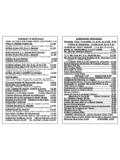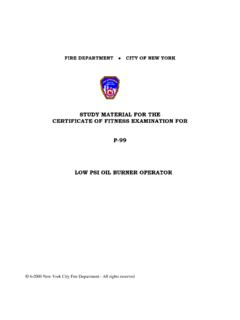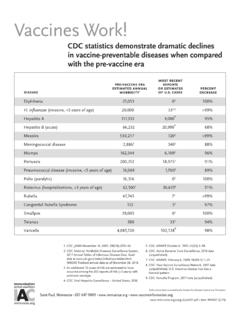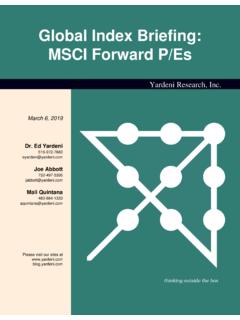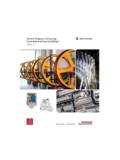Transcription of SURVIVAL OF LARVAL AND CYST STAGES OF GORDIIDS ...
1 J. Parasitol., 99(3), 2013, pp. 397 402. American Society of Parasitologists 2013. SURVIVAL OF LARVAL AND cyst STAGES OF GORDIIDS ( nematomorpha ) after . EXPOSURE TO FREEZING. Matthew G. Bolek, Erin Rogers, Cleo Szmygiel, Ryan P. Shannon, Whitney E. Doerfert-Schrader* , Andreas Schmidt- Rhaesa , and Ben Hanelt*. Department of Zoology, Oklahoma State University, Stillwater, Oklahoma 74078. Correspondence should be sent to: ABSTRACT: Hairworms infect terrestrial arthropods and are 1 of the most understudied groups of parasites. Recently, life cycles of 2. GORDIIDS (Paragordius varius and Paragordius obamai) have been domesticated in the laboratory. We tested the viability of laboratory reared and post-frozen LARVAL and cyst STAGES of the North American gordiid, P. varius, frozen at 80 C for 7 mo, and the viability of eld collected and post-frozen cysts of the African (P.)
2 Obamai) and North American (P. varius) gordiid frozen at 20 C for 2 mo. All snails exposed to post-frozen or control P. varius larvae became infected with cysts, and there was no signi cant difference in prevalence or mean intensity of cysts among control or experimental snail groups. As with larvae, no signi cant differences were observed in prevalence or mean intensity of emerging worms from crickets infected with post-frozen or control P. obamai or P. varius cysts. All female P. obamai and P. varius worms from control and post-frozen cyst infections laid eggs and larvae hatched from some of these eggs. SURVIVAL and cyst formation of P. varius larvae exposed to different combinations of drying and/or freezing temperatures indicated that gordiid larvae have the ability to survive drying and freezing, but SURVIVAL signi cantly increases during freezing at lower temperatures.
3 The major contribution of our study is the demonstration that gordiid LARVAL and cyst STAGES can survive freezing temperatures to infect and develop in the next host. The nematomorpha represent 1 of 3 entirely parasitic animal free-living adults (Hanelt and Janovy, 2004a, 2004b; Hanelt et al., phyla (Hanelt et al., 2005). Two classes exist within the phylum 2012). Juvenile GORDIIDS are obligatory parasites of terrestrial and include the marine Nectonematida and the freshwater arthropods, whereas a variety of animals serve as paratenic hosts Gordiida (Schmidt-Rhaesa, 1997). Nematomorphs, or hair- for the cyst stage (Hanelt et al., 2001; Bolek and Coggins, 2002;. worms, are 1 of the most understudied groups of animals (Poulin, Hanelt and Janovy, 2003, 2004b). However, many questions still 1998), but they have recently gone through a scienti c renaissance remain on how hairworm life cycles are maintained in nature.
4 For (Hanelt et al., 2005). Within the last 15 yr, work on GORDIIDS has example, we do not fully understand how gordiid LARVAL and cyst focused on understanding their distribution (Schmidt-Rhaesa, STAGES survive winter in the environment for gordiid species 1997; Bolek, 2000), taxonomy (Schmidt-Rhaesa, 2002; Schmidt- distributed in geographical areas with a temperate climate. One Rhaesa et al., 2003, 2008; de Villalobos et al., 2009; Bolek et al., thought is that larvae and/or cysts of these species must somehow 2010; Chiu et al., 2011; Begay et al., 2012), life history (Hanelt and overwinter by suspending their life cycles during cold periods and Janovy, 1999, 2003, 2004a, 2004b; Hanelt et al., 2012), and infect arthropod hosts during the spring, when temperatures are ecology (Bolek and Coggins, 2002; Hanelt, 2009; Sato et al.)
5 , more suitable for their potential hosts. 2011). Emphasis has also been placed on using nematomorphs as Although we have made signi cant progress in maintaining model systems to study the biochemical mechanisms of host gordiid life cycles in the laboratory, one major problem with manipulation (Thomas et al., 2003; Biron et al., 2005) and as continuous cultivation of GORDIIDS in the laboratory is the indicators of environmental stressors (Zanca et al., 2007; logistical burden of maintaining colonies of numerous species of Achiorno, de Villalobos, and Ferrari, 2008; Achiorno, Ferrari, hosts for infections, especially when the appropriate numbers of and de Villalobos, 2008; Achiorno et al., 2009, 2010). these hosts are not available when infected STAGES of GORDIIDS are The life cycles of 2 species of GORDIIDS (Paragordius varius and available.
6 One possible solution in overcoming these dif culties is Paragordius obamai) have been domesticated in the laboratory, to develop techniques in suspending life cycle STAGES of GORDIIDS allowing investigators to test hypotheses about gordiid host until colonies of the appropriate hosts are available for infection. interactions, ecology, and evolution (Hanelt and Janovy, 2004a;. Recent studies by Achiorno, Ferrari, and de Villalobos (2008). Hanelt et al., 2012). The diecious North American P. varius has indicate that larvae of the Argentinean gordiid, Chordodes nobilii, been maintained in culture for over a decade (Hanelt and Janovy, remain infective to their paratenic hosts after exposure to 2004a). More recently, the rst parthenogenetic gordiid, P. obamai, temperatures of 3 C for 48 hr, suggesting that larvae and other was discovered in Kenya and is currently maintained in culture in gordiid life STAGES may be resistant to freezing.
7 The purpose of this our laboratories (Hanelt et al., 2012). Studies on these domesticated study was to determine if freezing larvae and/or cysts of 2 species hairworms indicate that life cycles of GORDIIDS involve 5 distinct life of gordiid from North America and Africa for long periods of STAGES , including (1) egg strings, (2) free-living larvae, (3) parasitic time could successfully produce infections in their respective cysts, (4) parasitic juveniles, and (5) diecious or parthenogenetic paratenic and de nitive hosts. Additionally, because a number of invertebrate taxa have been reported to survive drying and/or Received 25 August 2012; revised 1 December 2012; accepted 19. December 2012. freezing (Stanley et al., 1994; Holmstrup et al., 2002), we wanted * Center for Evolutionary and Theoretical Immunology, Department to determine if P.
8 Varius larvae were resistant to drying or freezing of Biology, University of New Mexico, Albuquerque, New Mexico at low ( 70 6 2 C) or high temperatures ( 30 6 3 C) or a variety 87131. of these conditions. Simply placing gordiid larvae and cysts into a Present address: Farmington High School, 2200 Sunset Avenue, Farmington, New Mexico 87401. freezer does not allow differentiation between the effects of Zoological Museum and Institute, Biocenter Grindel, Martin-Luther- supercooling or internal freezing of the organism, and either or King-Platz 3, 20146 Hamburg, Germany. both of these effects may occur during the freezing treatment used DOI: in this study. 397. 398 THE JOURNAL OF PARASITOLOGY, VOL. 99, NO. 3, JUNE 2013. MATERIALS AND METHODS were then placed in 2 1-ml plastic Eppendorf tubes led with ml of Gordian worm maintenance and original larva source aged tap water and frozen at 80 6 2 C for 7 mo.
9 Frozen snails from each of the 2 Eppendorf tubes were thawed at room temperature (25 6 2. Physa gyrina snails infected with cysts of the North American C) and the shells were removed. cyst isolation and cricket infections diecious gordiid, P. varius, were collected with a dip-net from Millville followed the same procedures as for the original isolation of P. varius. Creek ( , ), Lancaster County, Nebraska, stored in Two groups of 70 G. rmus crickets were exposed to post-frozen and an bucket with stream water and a portable air pump, and control cysts of P. varius, respectively, and exposed crickets were brought back to Oklahoma State University. Snails were examined for maintained as previously described. the presence of cysts as previously described by Hanelt et al. (2001). within a week of collection.
10 Brie y, shells were removed from each snail Infectivity of field collected and post-frozen cysts of Paragordius and the soft tissue was crushed between 2 slides. Each snail was infected obamai and Paragordius varius naturally with 0 78 cysts (average 16), determined by dissecting 10. In order to test if eld collected cysts of gordiid species were viable after snails. To isolate gordiid cysts from snails for cricket infections, the soft they were placed in a freezer at higher temperatures ( 20 C), we collected tissue was macerated with a razor blade. A small portion of the soft snails infected with P. obamai and P. varius cysts from Africa and North tissue from a single snail containing approximately 0 15 gordiid cysts America, respectively. Biomphalaria pfeifferi snails infected with the was fed to a 24-hr-starved commercially reared cricket Acheta parthenogenetic P.

